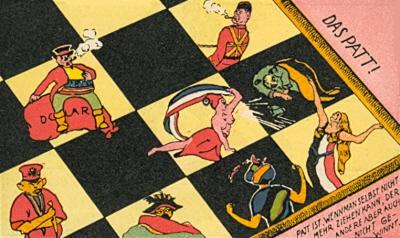
Edward Winter

‘The stalemate is the penalty for mauling without killing’ was the prize-winning entry in a New Statesman and Nation competition in the 1950s. The remark came from a Mr Hamburger, according to Assiac, the magazine’s columnist (see page 63 of his book The Pleasures of Chess). [Addition on 29 August 2024: regarding the Hamburger observation, the exact text and source are now given at the end of the present feature article.]
In the present compendium of little-known examples of stalemate, we begin with what is probably the most common form, arising in a queen ending:

C.A. Walbrodt-T. von Scheve, Berlin, 1891 (Black to move)
81…Qd6+ 82 Kxd6 Stalemate.
Source: International Chess Magazine, September 1891, pages 269-271.
A similar example comes from an offhand game at the Melbourne Chess Club between unidentified players:
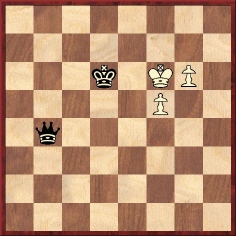
White to move. Play went 1 g7 Qg4 (Black could win with, for example, 1…Qd4+ 2 Kf7 Qd5+ or 2 Kg6 Qg4+.) 2 g8(Q) Qxg8 Stalemate.
Source: BCM, June 1916, page 195.

C. Wieckmann-Labbé, Reval, 1903 (White to move)
Play continued as follows: 1 Nf4+ Kf1 2 Ne2 g3 3 Kf3 g2 4 d5 h3 5 d6 h2 (Black misses 5…g1(Q), which would win.) 6 Ng3+ Kg1 7 d7 h1(Q) 8 d8(Q) Qh3 (‘The only move.’) 9 Qd2 Kh2 10 Qf2
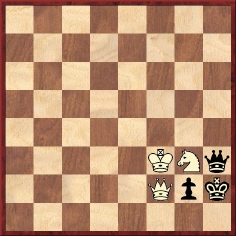
10…Qg4+ 11 Kxg4 Stalemate.
Source: Deutsches Wochenschach, 17 January 1904, page 24.
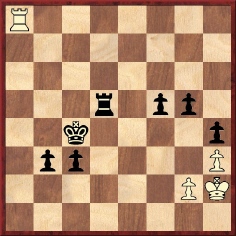
The above position (White to move) occurred in a game at the Perth Chess Club, White being the 15-year-old Vernon Stannard. He played 1 Re8 c2 2 Re1 Rd1 3 Re2 c1(Q) 4 Rc2+ Qxc2 Stalemate. With 4…Qxc2 Black contrived to play the only move which did not win.
Source: Australasian Chess Review, 30 April 1939, page 94.
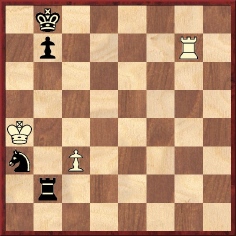
L.G. Eggink (simultaneous)-v.d. Wyngaard, Magelang, 1911 (Black to move)
Instead of moving his attacked knight to b1 or b5, Black played 1…Nc4, setting up the mating threat 2…b5. However, White obtained an immediate draw with 2 Rxb7+.
Source: Deutsches Wochenschach, 3 September 1911, page 320.
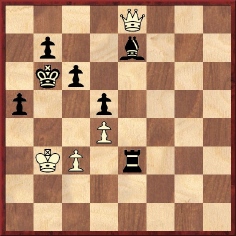
This position, with White to move, arose in a correspondence game between Kandler and Josef Schwarzbach. Black has just played his rook from e4 to e3, and White replied 1 Ka4. Now it may seem that Black can win by 1…Rxc3 2 Qxe7 Ka6, threatening 3…b5 mate, but White achieves stalemate by means of 2 Qd8+.
Source: Deutsches Wochenschach, 15 January 1911, page 26.
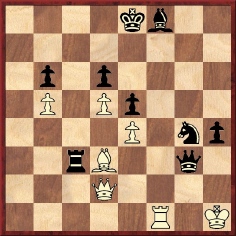
J.H. Blackburne -S. Winawer,
Dresden, 26 July 1892 (Black to move)
Black played 49…Rxd3, which Blackburne answered with 50 Rxf8+, and the game was drawn. If 50…Kxf8 51 Qxh6+, and White will draw by stalemate.
Sources: Deutsche Schachzeitung, September 1892, pages 270-272 and the Dresden, 1892 tournament book, pages 167-169.
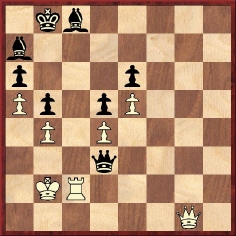
L. Jellinek-G. Heilpern, Vienna,
13 May 1915 (White to move)
Play went 1 Qc1 Bxd4+ 2 Ka2 Bb7 3 Rc8+ Ka7 4 Ra8+ Kxa8 5 Qc8+ Ka7 6 Qa8+ and stalemate follows.
Source: Wiener Schachzeitung, March-April 1916, page 96.
The finish is ingenious but 1…Bxd4+ was by no means forced, as 1…Qxd4+ or 1…Bb7 should win for Black. Moreover, from the diagrammed position, White could force the draw with 1 Rxc8+ Kxc8 2 Qg8+ Kb7 3 Qf7+ Ka8 4 Qe8+ Bb8 5 Qc6+.
Finally, a position in which a master misses a simple stalemate opportunity. It happened in the game between E. Lundin and W.R. Hasenfuss at the Prague, 1931 Olympiad:
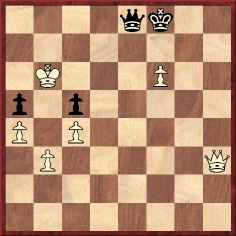
Black played 68…Qb8+ and had to resign ten moves later. Instead he could have drawn immediately with 68…Qe6+.
Sources: Šachová Olympiada v Praze 1931, page 227 and Tidskrift för Schack, August-September 1931, page 157.
As is well known, it was only in the early nineteenth century that stalemate came to be regarded as a draw. The old rule is shown in the excerpt below from page 32 of Studies of Chess (London 1803):
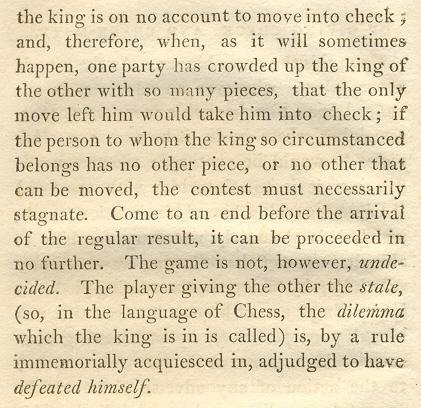
For an historical tailpiece here, it may also be noted that even in the mid-nineteenth century there was still discussion about whether an en passant capture, normally optional, was obligatory in cases where it relieved an otherwise stalemate position. On page 5 of his 1860 book Chess Praxis Staunton wrote:
‘A “forced move” is when a player can only make one move, and the taking a pawn in passing is to be considered a forced move when the player has no other.’
Charles Tomlinson recalled on pages 501-502 of the November 1891 BCM that the above wording had come about after he had submitted for discussion the following position:
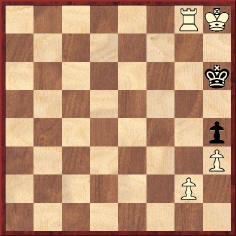
‘I set up the annexed position, and put the question whether, in order to escape a stale mate, the second player could be compelled to take the P en passant. In this position, White having to play, advances the Knight’s Pawn two squares, whereupon Black calls out Stale mate! No, retorts White, you can take the Pawn en passant. But that is at my option, returns Black, it is a purely voluntary move, and I don’t choose to make it. In this contention, I held Black to be in the right, it is a purely voluntary move, and the definition of a stale mate as generally given, to be faulty:- “A stale mate is when a player whose King is not in check, and whose turn it is to play, has no move except such as would put his King in check.” The committee [on revising the laws of chess, comprising Messrs Löwenthal, Ingleby, Wayte and Tomlinson] agreed with me that the law required amendment…’ [This shows that capturing en passant is not always a ‘privilege’, to quote the term used twice on page 93 of An Illustrated Dictionary of Chess by Edward R. Brace.]
Another simple position illustrating the point appeared on page 21 of The Kipping Chess Club Year Book 1943-1944:
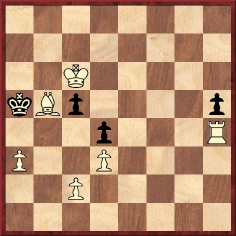
Mate in two moves
Solution: 1 c4 dxc3 2 Ra4 mate.
Suggestions for further reading on stalemate:
Chess Café, 1999
An unusual finish occurred in the consultation game H. Seyboth and M. Chigorin v A. Lewin and E. Schiffers, played on 13 September 1900 in St Petersburg. Here is the position after Black’s 35th move:

The remaining moves were 36 Qxg8+ Kxg8 37 Rxf7 Qe3 38 R7f3 Qh6 39 Kh3 Kg7 40 Rg3+ Kh8 41 Rf7 b5 (Black’s king and queen are now stalemated.)
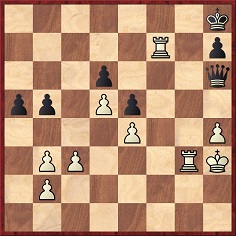
42 Rg5 Resigns.
Source: Wiener Schachzeitung, December 1900, page 257.
(515)
This position comes from the game between B.E. Maliutin and B. Gregory at the 1912 Breslau Hauptturnier (page 177 of the tournament book).
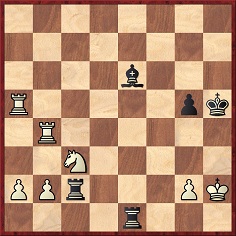
White played 42 Ne4 Bc4 43 Rxg5+ Kh4 44 Rxc4 (with the idea of 45 g3 mate) 44...Rh1+ 45 Kxh1 Rc1+ 46 Kh2 Rh1+ 47 Kxh1 Stalemate.
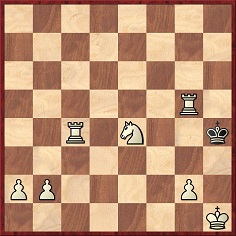
(1116)
The August 1893 BCM (page 342) quotes from the New Orleans Times-Democrat:
‘A Baltic Chess Curio. – Stalemates in chess are common enough, or at least not uncommon, but a position where both parties are left in that unenviable condition of “innocuous disuetude” is certainly curious. Such, as the reader will note, is the extraordinary outcome of the following position, which occurred in actual play some years ago at Fellin, Livonia, and which we find in the recently published concluding Part IV of Herr Amelung’s Baltische Schachblätter:
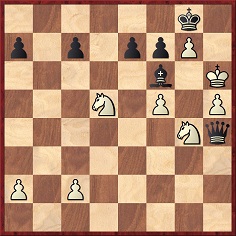
F. Amelung-G. von Helmersen
White, having to play, of course drew as follows: 1 Ngxf6+ (a) Qxf6+ (b) 2 Nxf6+ exf6 3 c4 c5 4 a4 a5. And each party is in a stalemate position: (c)
(a) Nota bene, taking with the other knight would not do, as Black could reply 1...exf6:, and wins, which illustrates the fact that in chess there is sometimes considerable “difference ’twixt tweedledum and tweedledee”.
(b) The queen, of course, must capture, for if now 1...exf6 2 Ne7 mate.
(c) Whereby surely “honours are easy”; there is no room on either side even for the traditional chess “if”.’
(1584)
C.N. 1640 published the following position, taken from page 75 of Echecs et mythe by Arrabal (Paris, 1984):
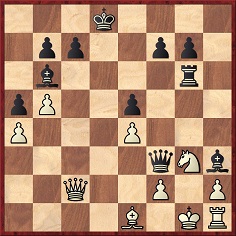
‘Tritsky v Folk, 1896.’ White draws by 1 Qd1+.
We now note that page 195 of the 13 June 1897 issue of Deutsches Wochenschach and page 181 of the June 1897 Deutsche Schachzeitung give:
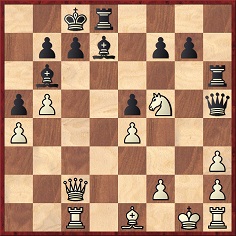
Played by Troitzky (St Petersburg) in a knight’s odds game. 1...Rg6+ 2 Ng3 Qf3 3 Rd1 Bxh3 4 Rxd8+ Kxd8 5 Qd1+ Qxd1 Stalemate.
Wanted: the complete score and pertinent details, as well as other examples of stalemate on a relatively crowded board.
(2021)
Julián Alonso Martín (Seville, Spain) sends the next position, from page 130 of the 2 October 1989 issue of the Spanish weekly publication Cambio 16:
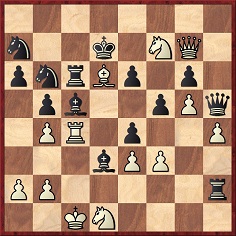
This is said to be from a game in which White, Prince N. Galitzin (Golitsyn), played: 1 Nd8+ Kxd6 2 Nb7+ Kd5 3 Qe5+ Kxe5 4 f4+ Kd5 5 Nc3+ Kxc4 6 Na5+ Kxb4 7 a3+ Kxa5 8 b4+ Bxb4 9 axb4+ Kxb4 Stalemate.
Who can provide more information?
(2069)
Since writing C.N. 2069 we have found that a similar diagram (White to draw, composer not named) appeared on page 96 of the February 1854 Deutsche Schachzeitung and on page 321 of Deutsches Wochenschach, 15 September 1907. Compared with the diagram above, both these sources omit the units at b4, b5, c4 and h4 but have a black pawn at e5. The solution is the same.
(2132)
Below is a rare instance of an announced stalemate:
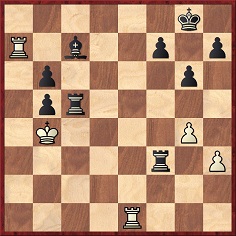
E. Delmar-S.M.B., Skaneateles, August 1892
Black played 1…Rxh3 and after 2 g5 Rg3 Delmar ‘announced stalemate in four [sic] moves’.
Source: American Chess Monthly, October 1892, page 210.
(2544)
The position below comes from page 68 of Schach by H. Ranneforth (Leipzig, 1936), which merely states that White was A. Jülich and that the game was played in 1906:

Play is said to have gone 1 Rd2+ Bxd2 2 Rd3+ Kxd3 3 Qe2+ Kd4 4 Qd3+ Ke5 5 Qf5+ Kd6 6 Qd7+ Drawn.
(2651)
With regard to the stalemate composition discussed on page 22 of Kings, Commoners and Knaves (C.N. 2069), we have now noted its prior publication on page 383 of the 1853 Chess Player’s Chronicle, where the composer was identified as ‘E.A.M.M. of India’, which was the pseudonym of Ernest Augustus Murray MacGregor (1825-69).
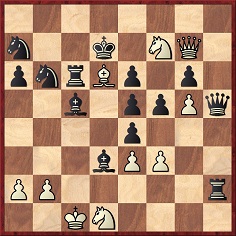
White to move and draw
Solution: 1 Nd8+ Kxd6 2 Nb7+ Kd5 3 Qxe5+ Kxe5 4 f4+ Kd5 5 Nc3+ Kc4 6 Na5+ Kb4 7 a3+ Kxa5 8 b4+ Bxb4 9 axb4+ Kxb4 Stalemate.
The ending later appeared, with no mention of E.A.M.M., on page 26 of the September 1884 Chess Monthly, with this heading:
‘The following interesting ending was dedicated to the Vienna Chess Society by the well-known Russian player, Prince Nicolaus Galitzyne, on his recent visit to Vienna.’
On page 32 of Chess Potpourri (Middletown, 1931) Alfred C. Klahre suggested that this stalemate was ‘perhaps the most amusing one ever conceived’. The version with additional units (i.e. as in the diagram in the above-mentioned item in Kings, Commoners and Knaves) appeared on page 24 of La Stratégie, 15 January 1886, under the title ‘Endgame … by Prince Nicolas Golitzyne, in St Petersburg’.
We have yet to find a satisfactory explanation for the existence of two versions or for the involvement of the Prince. Certainly, though, he was a chess enthusiast, and a rare specimen of his play was published on pages 153-154 of the May-June 1883 Deutsche Schachzeitung:
S. – Prince N.N. Galitzin
Correspondence game
King’s Gambit Accepted
1 e4 e5 2 f4 exf4 3 Nf3 g5 4 h4 g4 5 Ne5 d5 6 exd5 Qe7 7 Qe2 Nf6 8 d4 Nh5 9 Qf2 Bh6 10 Nc3 f6 11 d6 cxd6 12 Nd5 Qg7 13 Bb5+ Kd8 14 Nd3 Nc6 15 O-O g3 16 Qe1 Re8 17 Qc3

17…Qg4 18 Rxf4 Bxf4 19 N3xf4 Qxh4 20 Be3 Nxf4 21 Nxf4 Bg4 22 d5 Re4 23 Ne2 Bxe2 24 Bxe2 Qh2+ 25 Kf1 Qh1+ 26 Bg1 Rf4+ 27 Bf3 Nd4 28 White resigns.
We seek reliable biographical information about the Prince.
(2700)
A footnote on page 56 of A Chess Omnibus reported that in his book on Morphy (page 195) F.M. Edge related an encounter between the American master and Prince Galitzin.
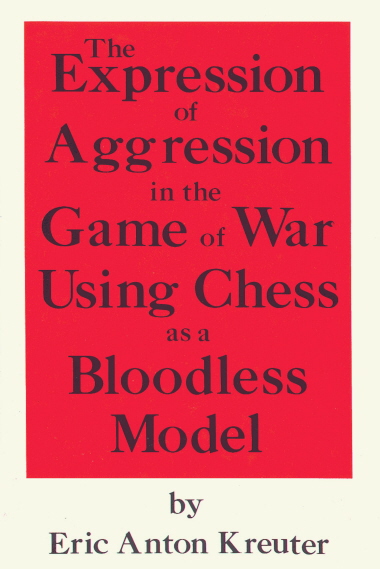
From page 45 of The Expression of Aggression in the Game of War Using Chess as a Bloodless Model by Eric Anton Kreuter (New York, 1991):
‘Chess playing requires a similar deployment of strategies and tactics as in war. Certain chess games result in stalemates due to either a passive playing style or too many equal sacrifices. Stalemated chess games, like prolonged, victor-less wars result from both sides’ inability or unwillingness to execute a more aggressive style of attack.
Perhaps the same killing inhibition which stops a chessplayer from waging an all-out attack on the chessboard is affecting the society which is unable to penetrate enemy forces sufficiently enough to result in the end of the war.’
(2832)
For the full C.N. item regarding the book, see Chess and War.
C.N. 52 gave the following piece of play and asked if the full game-score was available. Nothing more has been found.
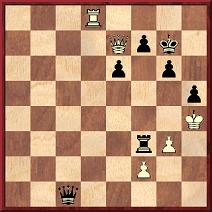
‘Lazdies -Zenitas, Riga, 1936’
White is said to have played 1 Qf8+ Kf6 2 Qh8+ Kf5 3 g4+ hxg4 4 Rd5+ exd5 5 Qc8+ Drawn.
We took the position from page 64 of The Pleasures of Chess by Assiac (New York, 1952), but another secondary source, page 268 of Kurzgeschichten um Schachfiguren by Kurt Richter (Hollfeld, 1991), gives the players’ names as Lazdiņš and Zemītis and the date as 1935.
(4120)
This position (White to move) comes from page 22 of the November 1900 Schweizerische Schachzeitung:
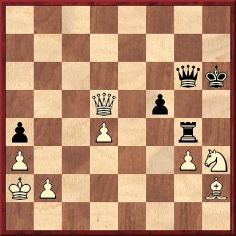
N.N.-J. Juchli, Zurich, before 1900
1 Nf4 Rxf4 2 gxf4 Qf7 3 Qxf7 Stalemate.
(5056)
Elmer Sangalang (Manila, the Philippines) asks when stalemate came to be adjudged a draw.
It is a matter which H.J.R. Murray examined not only in his book A History of Chess (Oxford, 1913) but also in an article, ‘Stalemate’, on pages 281-289 of the July 1903 BCM. In the latter source he noted, regarding ‘parallelism to real warfare’, that stalemate most closely resembled a situation ‘in which one monarch retired to an impregnable fortress’ and that:
‘The issue of such a condition was obviously doubtful; sometimes the blockaders might succeed in starving him into surrender, but sometimes with ample supplies the besieged monarch would succeed in wearying his opponents until they abandoned what appeared a hopeless enterprise. With no certain assistance from actual life, the evaluation of the position in the game of chess was left to the fancy of players, and the laws of stalemate have varied from age to age, and from place to place.’
Further extracts from Murray’s article:
‘The revival of interest in chess as a game, which dates from the rise of New Chess, towards the end of the fifteenth century, led to the appearance of books on chess which were other than mere collections of problems. From Lucena’s work (1497) we learn that stalemate was then called in Spain mate āogado, and the player who was stalemated lost half his stake. Ruy López calls it mate ahogado, and gives the same evaluation. To give stalemate was accordingly reckoned in Spain as an inferior form of victory, which was yet more profitable than a draw. With the Italian school, stalemate was reckoned as identical with a draw.’
‘With the beginning of the seventeenth century, a new convention with regard to stalemate makes its appearance, apparently in England. ... Arthur Saul is the first writer to enunciate the rule that the player whose king was stalemated had won the game.’
‘Whatever may have been the origin of Saul’s rule, it rapidly became the accepted rule in English chess. ... The war against the English rule was commenced by Philidor, who naturally stood up for the rules as he had learned them in France. But even Philidor could not convert a nation at once, especially a nation which contained so confirmed a crank as Peter Pratt, the author of that preposterous attempt to convert chess into a game of politics, in which kings were to “closet” and not to castle, with much else of equal absurdity. As a persistent editor of Philidor’s analysis, Pratt was able to air his views under the shadow of the master, and was still in 1806 bravely defending the English rule of stalemate. To Sarratt, the almost forgotten master of Lewis, and the re-discoverer of the open game which most Englishmen still prefer, is due the credit of finally putting an end to the schism, which must indeed have in any case soon ceased with improved methods of inter-communication, and with the coming of the age of international matches and tournaments. The convention that stalemate draws thus became the rule of the European game ...’
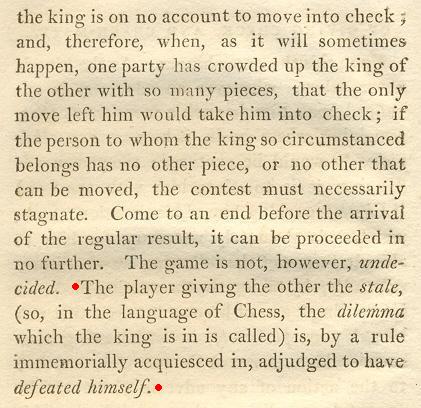
From page 32 of Studies of Chess by Peter Pratt (London, 1803 edition)
On pages 57-62 of A Short History of Chess (Oxford, 1963) Murray gave, in a country-by-country review of rule changes, the following information on stalemate:
‘Spain (including Portugal). Stalemate and the baring of the opponent (unless baring and mate occurred simultaneously) were inferior forms of victory at least as late as 1634, and possibly as late as 1750.’
‘Italy. Everywhere stalemate was a draw.’
‘France. Stalemate was a draw.’
‘England. Before 1600 stalemate became a win for the stalemated player. This ceased to be the rule of the chess clubs from about 1807 ...’
‘Germany. Hardly any two authors prior to Allgaier (1795) agree to their rules. [This was a general remark by Murray on rule changes, and not specifically related to stalemate.] Gustavus Selenus (1616): ‘Stalemate is a draw, but in some places the stalemated king wins.’ G.F.D. v. B. (manuscript of 1728): ‘Stalemate is a win for the stalemated king.’ Klemich (1872): ‘The stalemated king wins.’
We hope to find more specific information about the role of Sarratt. Murray’s article about him on pages 353-359 of the July 1937 BCM indicated that matters were unclear:
‘He [Sarratt] was a member, or at least a frequent visitor, of the London Chess Club, which met at Tom’s Coffee-house, Cornhill, and is said to have had a hand in drafting the Laws of Chess for this club. In these rules the older English rule that the stalemated player won was abandoned in favour of the Continental rule that stalemate is a draw.’
(5929)
From Robert John McCrary (Columbia, SC, USA):
‘In England for about 200 years stalemate was a win for the player who was stalemated. This paradoxical rule may have started with Arthur Saul’s The Famous Game of Chesse-play, published in London in 1614. In a section on page C3 called “The Diversity of Mates, and which are worthy of praise, or disspraise [sic]” he wrote, “The Stale, a dishonourable mate”. (Curiously, he also referred to “The Mate given with a Pawne, a disgraceful mate” and several other examples of “graceful or Honourable” mates or their opposite adjectives.) In Chapter XV, entitled “What a stale is, and how it is given”, Saul wrote: “... you shall understand that a stale is a lost game by him that giveth it, and no question to be made further thereof ...”, adding that players giving a stale “... purchase unto themselves such shame, which will not after be put away without much blushing”.
The rule that a player giving stalemate loses the game is repeated on page 91 of R. Lambe’s 1764 book The History of Chess: “... the King who is stale-mated wins the game”. On page 344 of the New York, 1857 tournament book Fiske quoted the Rou manuscript of 1734 as saying that this rule was observed only in England as of Rou’s day, and that elsewhere the position was drawn.
The rule was brought into the United States, as is shown by the first chess book by an American author: The Elements of Chess (Boston, 1805). Pages 13-14 said regarding stalemate: “... for the party thus crowding up the king is adjudged to have defeated himself, and his opponent is the winner.” Pages 19-20 presented advice on how to win by self-stalemate.
The rule disappeared during the early decades of the nineteenth century, as some subsequent English authors urged adoption of the stalemate-as-a-draw rule, although the controversy raged for a number of years before the change was accepted.
Page 38 of the second part of Phillip Stamma’s The Noble Game of Chess (London, 1745) had a composed position making use of the rule that a stalemated player wins:
Stamma gave “1 Rb8+ Nxb8 2 a7 ‘&tc.’.” English readers would have understood the “&tc.” as “White wins”. That is because the knight must move to avoid mate, but the resulting stalemate of White also wins for White.
Are there other examples of this paradoxical stalemate rule in compositions or games of the time?’
(6565)
In a letter on page 7 of the January 1937 Chess Review Herbert Harvey proposed a rule change whereby a pawn would ‘become by promotion automatically the piece appropriate to the file on which it is promoted’. A choice of pieces would exist only in case of promotion on the king’s file.
On page 29 of the following month’s issue Paul H. Litwinsky (later: Paul H. Little) related an ‘offhand remark’ by Capablanca at Nottingham, 1936, regarding stalemate:
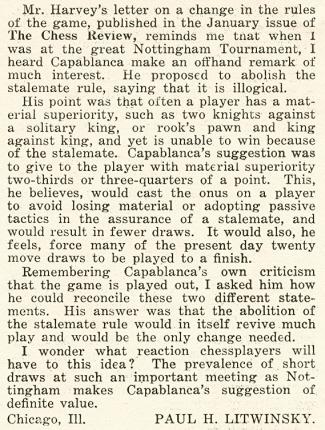
(7051)
From page 2 of the October 1915 Chess Amateur:
‘Not Stalemate but Deadlock in describing the War
Many newspapers, magazines, journals and books have, on various occasions, alluded to the situation in the Dardanelles and in France as that of a “stalemate”, painfully illustrating the truth of the adage how dangerous a thing is a little knowledge. No-one with any real familiarity with chess would use the expression stalemate in describing the war in either of its areas, which would convey the idea that it was all over and a draw had resulted. A deadlock perhaps at one time would have been a correct definition, but a stalemate is a climax, a finality, and is absolutely misleading. The Germans in this awful contest would jump at a stalemate, but their opponents have got some good “moves” to spring upon them at the psychical moment, when the Kaiser will be effectually checkmated – a totally different matter to being stalemated.’
(7116)
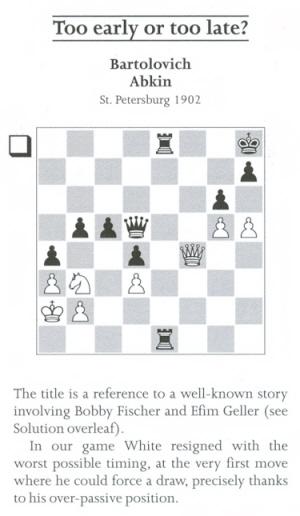



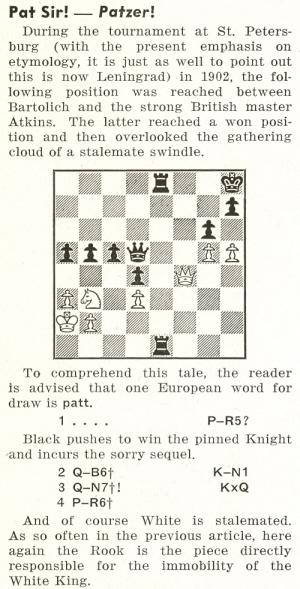
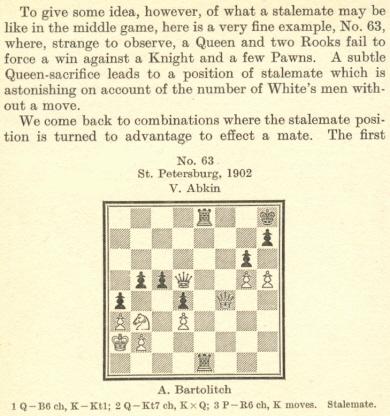
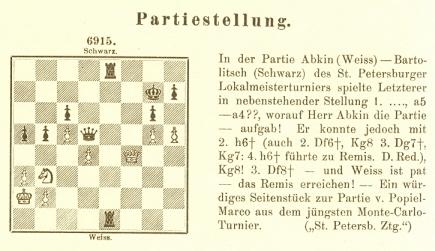
Thus the players’ names are variously given as Bartolovich, Bartolish, Bartolitsch, Bartolich, Bartolitch and Abkin, Atkin and Atkins.
The earliest version, from Deutsche Schachzeitung, mentions a source (‘St Petersb. Ztg’), but can the relevant issue of that newspaper be traced?
As regards the occasion of the game, the crosstable of a tournament played in St Petersburg, 1902 is on page 187 of volume two of Chess Tournament Crosstables by J. Gaige (Philadelphia, 1971). Abkin and Bartolich were participants, and Abkin lost their individual game. That corresponds to the DeutscheSchachzeitung version, which states that Abkin was White. It is also the only version to have a different configuration for the queen’s-side pawns.
(7254)
Concerning the Abkin v Bartolich ending, Vitaliy Yurchenko (Uhta, Komi, Russian Federation) draws attention to page 153 of Шахматное обозрение, March, April and May 1902:
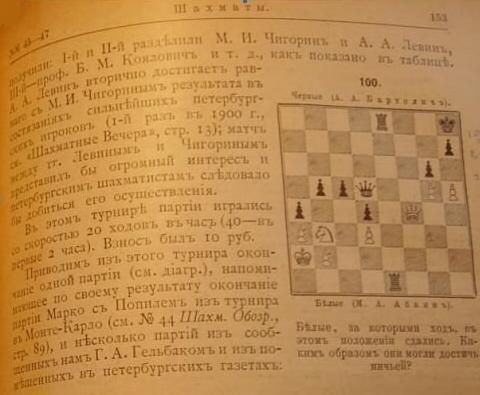
Mr Yurchenko comments that the same configuration of queen’s-side pawns was given on page 102 of Шахматный журнал, April 1902.
(7265)
Patsy A. D’Eramo (North East, MD, USA) forwards page 4 of the San Francisco Chronicle, 11 January 1903, comprising a lengthy article entitled ‘A Chess Talk with Lasker the Champion’.
Among the interesting material is an explanation of a game invented by him, checkerette, and the following comments on chess:
‘I am sorry to say that I do not much care whether I win or not now.’
‘At present a stalemate is regarded as a drawn game. Undoubtedly it will soon be considered a victory for the player who places his opponent in such a position.’
(8188)
A small feature in the Chess Amateur, September 1928, page 369:
‘The Inevitable Blunder: – How many authors and journalists go wrong over the term “stalemate”? Legions of them. Here is the usual mistake:
“I watched him silently, unable to decide whether to continue the futile argument or not. There was stalemate between us. He had as strong a hold on me as I had on him.” (J. Chancellor in The Mystery of Norman’s Court, Chapter vii).’
The fact is, of course, that in the ordinary language the word has not really changed its meaning.’
The on-line Oxford English Dictionary cites two figurative uses of ‘stalemate’:
Below is the entry on page 1593 of the Collins Dictionary (Glasgow, 2011):
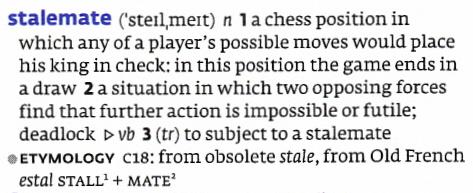
(8607)
Although a very good book overall, the Oxford Advanced Learner’s Dictionary (Oxford, 2010) makes little effort with its definitions of basic chess vocabulary ...
...On page 1502 ‘stalemate’ in the chess sense is defined thus:
‘A situation in which a player cannot successfully move any of their pieces and the game ends without a winner.’
(8621)
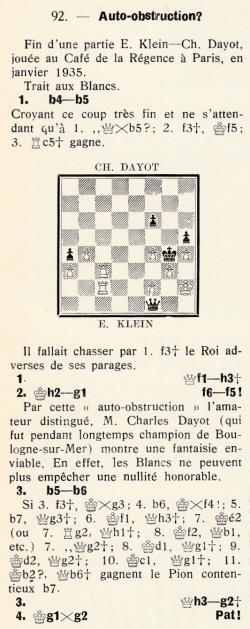
Source: Tartakower’s column on page 998 of L’Echiquier, March-April 1935.
Can further details be found about this specimen of stalemate?
(8800)
C.N. 7051 above has a remark by Capablanca at Nottingham, 1936 that the stalemate rule is illogical. Another comment, made in 1919, was reported by P.W. Sergeant on page 457 of the December 1929 BCM:
‘To take the case of stalemate alone, during the Victory Congress at Hastings I had a discussion with Señor Capablanca, who argued that the old rule that the player who could make no move should lose is far more logical than the present rule, and should be restored.’
(9121)
The conclusion of Kestler v Pesch, Traben-Trarbach, 1956 has been widely published, but is the full game available?
From page 153 of How To Get More Out Of Chess by F. Reinfeld (New York, 1957):
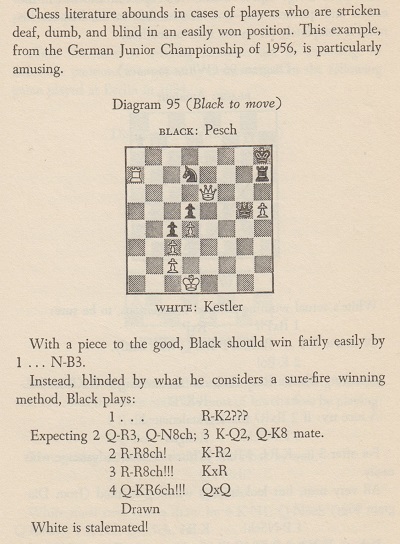
(10449)
Further to C.N. 2761 (see Chess Cunning, Gamesmanship and Skulduggery), Jonathan Hinton (East Horsley, England) draws attention to a similar, earlier case, reported on page 65 of Chess World, April 1953:
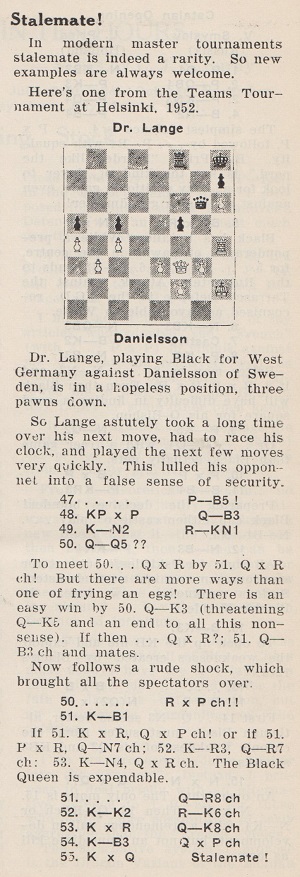
(10520)
Pages 281-284 of The Principles of Chess in Theory and Practice by James Mason (London, 1894):
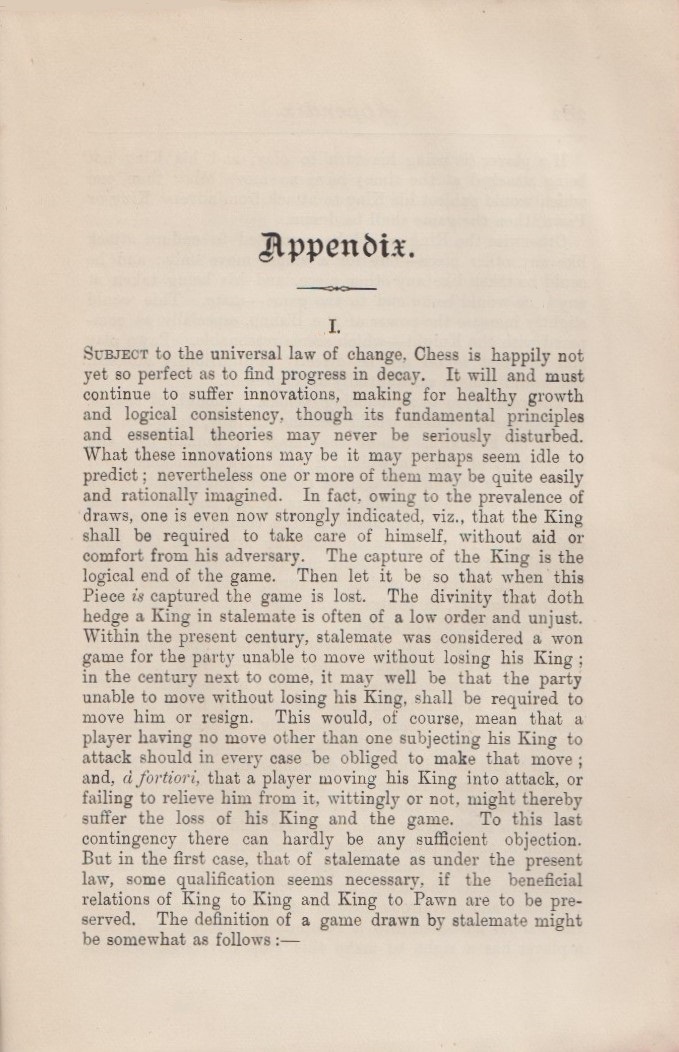
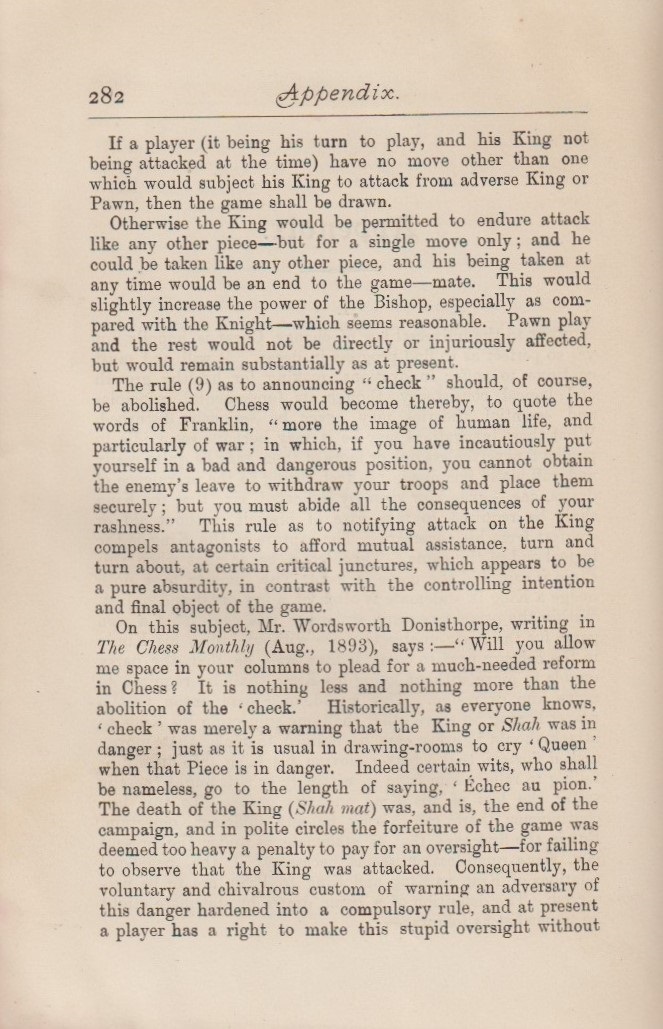
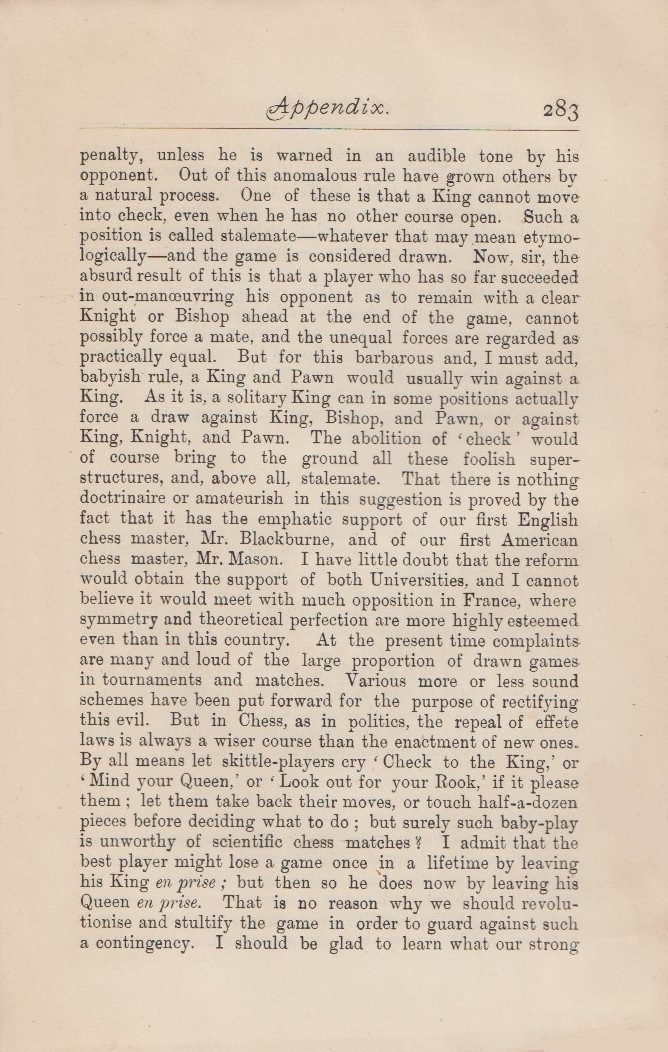
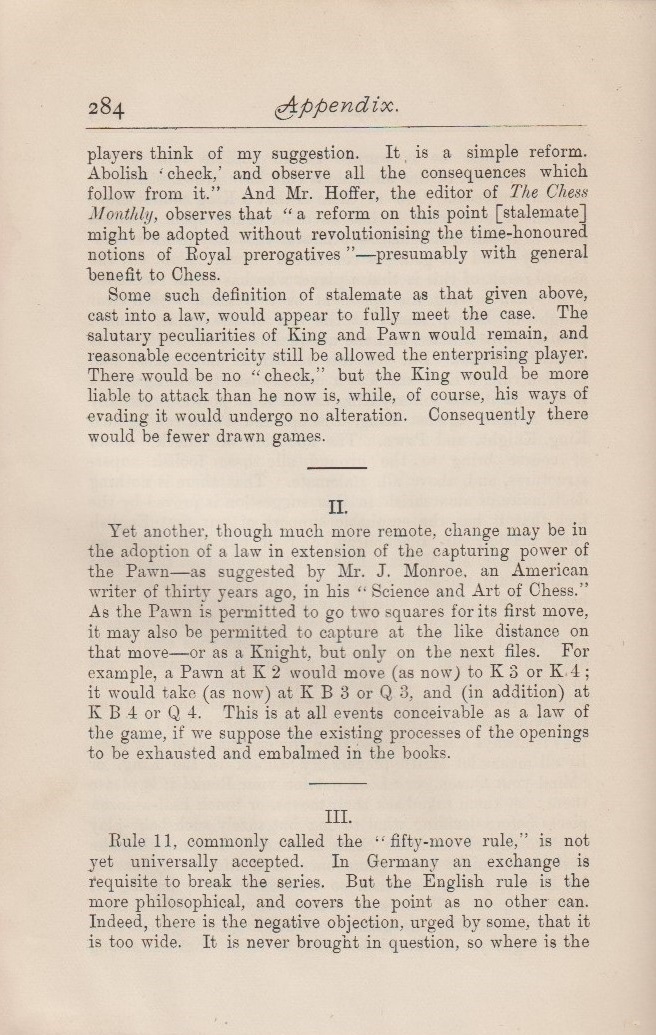
From page 89 of How to Win When You’re Ahead by Fred Reinfeld (New York, 1955):
‘Centuries ago, when the stalemate drawing rule was first devised, it was doubtless intended as a punishment for careless or greedy players. Today it is mostly a refuge for desperately ingenious players who manage to find what is sometimes the only way out of an otherwise hopeless situation.’
C.H.O’D. Alexander wrote on page 10 of Fischer v. Spassky Reykjavik 1972 (Harmondsworth, 1972):
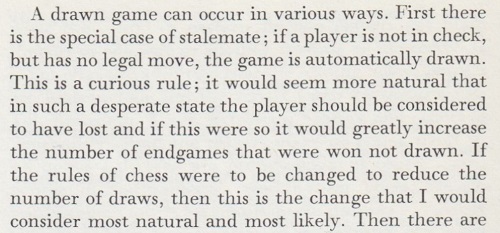
In a letter on page 160 of CHESS, March 1973 T.D. Harding disagreed. Paul V. Byway disagreed with him on page 230 of the May 1973 issue, and Alexander wrote on page 258 of the June 1973 edition:
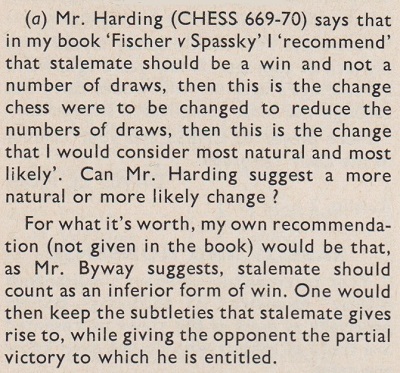
C.N. 7051 showed an account by Paul H. Litwinsky (later Paul H. Little) of an ‘offhand remark’ by Capablanca during the Nottingham, 1936 tournament:
‘He proposed to abolish the stalemate rule, saying that it was illogical.
His point was that often a player has a material superiority, such as two knights against a solitary king, or rook’s pawn and king against king, and yet is unable to win because of the stalemate. Capablanca’s suggestion was to give to the player with the material superiority two-thirds or three-quarters of a point ...’
(10984)
In the case of chess rules and definitions it is commonly accepted that the wording must be ‘perfect’ and foolproof, but inferior writers are often found wanting. An example comes from page 20 of Complete Book of Beginning Chess by Raymond Keene (New York, 2003):
‘Stalemate occurs when one side has no legal moves at all, but has not been checkmated. This is a draw.’
The simple diagram below shows that the definition is inadequate:

White has no legal moves and has not been checkmated. However, the game is not necessarily a draw by stalemate. It may be Black’s move.
Further specimens of stalemate are indexed in the Factfinder. See too the entries under En passant.
Additional feature articles: Chess: Stalemate by Self-Blockade (9 March 2021) and A Stalemate Manoeuvre (11 July 2022).
Addition on 29 August 2024:
After investigations in conjunction with the Cleveland Public Library, we can now give the precise source of the remark attributed to P. Hamburger. It appeared on page 133 of the New Statesman and Nation, 30 July 1949:
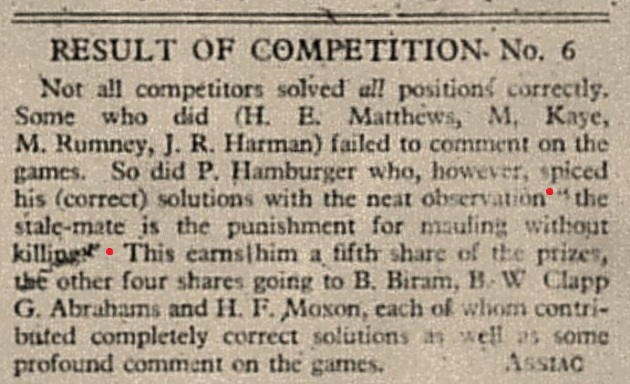
‘The stalemate is the punishment for mauling without killing’ is the 1949 wording attributed to P. Hamburger, i.e. ‘punishment’ and not ‘penalty’ as later given by Assiac (for example, on page 63 of his book The Pleasures of Chess).
About P. Hamburger we can say nothing at present. In addition to providing the above column, the Cleveland Public Library notes that the same 1949 volume of the New Statesman and Nation had a number of literary articles by Michael Hamburger (1924-2007), and that his brother was Paul Bertrand Wolfgang Hamburger (1926-2001). The latter became a famous publisher, having changed his name to Paul Hamlyn.
No relevant connection with chess has been established concerning either brother, except that the company Paul Hamlyn published a number of chess books.
Below are further thoughts on stalemate from Lasker, in his New York Evening Post column of 8 May 1907, page 7:
‘In olden times a sanctuary was a refuge for persecuted men who had no means of resistance. The sanctity of the place was respected, and often the vanquished in war escaped in this way the cruelty of the victors. The custom has died, but it has left a faint trace of its former existence in the ancient game of chesse [sic]. In the Middle Ages the rule was established that the king, in its most helpless position, when none of its side could move without exposing the king to capture, was safe, provided that the opponent had made no direct attack against the king. The position was called stalemate, and the game originally counted a win for the stalemated party, but is now reckoned a draw.
On account of this rule, the side that is under a disadvantage often escapes the rigorous punishment to which, in the logic of events, it would be exposed. The game would be a gainer in some respects if the rule were entirely abolished. It would then be easier to nurse small advantages to a win. But, as compensation, we have numerous fine combinations that owe their origin to the stalemate clause, and it gives a faint glimmer of hope to the weakened defender, even under the most desperate circumstances.’
(12076)
Addition on 22 May 2025:
Concerning Wahltuch v Griffith, Richmond, 1912, see Modern Chess Openings.

White to move
To the Archives for other feature articles.
Copyright: Edward Winter. All rights reserved.